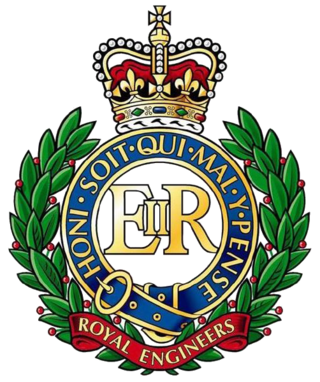The 2003 Defence White Paper, titled Delivering Security in a Changing World, set out the future structure of the British military, and was preceded by the 1998 Strategic Defence Review (SDR) and the 2002 SDR New Chapter, which responded to the immediate challenges to security in the aftermath of the September 11 attacks in 2001. Published under the then Secretary of State for Defence, Geoff Hoon, the report effectively introduced a series of cutbacks to core equipment and manpower and the scaling back of a series of future capital procurement projects. This was justified due to the implementation of a policy termed Network Enabled Capability. The review also outlined a major restructuring and consolidation of British Army Infantry regiments.

The 7th Armoured Brigade was an armoured brigade formation of the British Army. The brigade is also known as the "Desert Rats", a nickname formerly held by the 7th Armoured Division, of which the brigade formed a part during the Second World War until late 1941.

The 5th Infantry Brigade was a regular infantry brigade of the British Army that was in existence since before the First World War, except for a short break in the late 1970s. It was an Airborne Brigade from the early 1980s until amalgamating with 24th Airmobile Brigade, in 1999, to form 16 Air Assault Brigade.
This is the Operation Herrick ground order of battle, which lists any British ground forces that have taken part in the duration of Operation Herrick between 2002 and 2014.

23 Parachute Engineer Regiment is a Royal Engineers regiment in the British Army that was formed in 2003. It provides engineer support to 16 Air Assault Brigade in both the parachute and air assault role. The regiment is currently based at Rock Barracks in Suffolk and consists of three regular squadrons and one Army Reserve squadron. As part of 16 Air Assault Brigade it can be called upon to deploy on operations across the globe at extremely short notice.
Army 2020 was the name given to the restructuring of the British Army in the early and mid-2010s, in light of the Strategic Defence and Security Review 2010. The plan, as its name suggested, was intended to be completed by 2020, though most of its reorganisations were completed by the middle of the decade. It was succeeded by Army 2020 Refine, a series of new changes and refinements of Army 2020's restructuring, conducted in light of the Strategic Defence and Security Review 2015.

35 Engineer Regiment is a unit of the British Army's Royal Engineers under operational command (OPCOM) 8th Engineer Brigade, Force Troops Command. The Unit provided close support engineering under operational control (OPCON) to 20th Armoured Infantry Brigade. It is now an Explosive Ordnance Disposal and Search unit. It is located in Wimbish.
21 Engineer Regiment RE is a regiment of the British Army's Royal Engineers. It is based at Claro Barracks, Ripon, Catterick Garrison in Yorkshire.
26 Engineer Regiment is a regiment of the British Army's Royal Engineers. It is based at Swinton Barracks, Salisbury Plain, Wiltshire.

The 36 Engineer Regiment is a regiment of the Corps of Royal Engineers within the British Army. The regiment trace their history back to before World War II as 36 Army Engineer Regiment. The regiment today is a general support engineer regiment provided force support within 12 Engineer Group.

The structure of the British Army is being reorganised to the Future Soldier structure. The Army is commanded by the Chief of the General Staff (CGS), with Army Headquarters which is located in Andover, Hampshire. Subordinate to that post, there is a Commander Field Army, and a personnel and UK operations command, Home Command.
This is a list of units of the British Army's Royal Engineers.
The following is a hierarchical outline for the structure of the British Army in 1989. The most authoritative source for this type of information available is Ministry of Defence, Master Order of Battle, and United Kingdom Land Forces, HQ UKLF, UKLF ORBAT Review Action Plan, HQ UKLF, 1990.
The 72nd Engineer Regiment was a territorial regiment of the Royal Engineers, British Army, for three periods between 1967 and 2014. The regiment was later reduced to squadron size and renamed as 103 Field Squadron within the 21st Engineer Regiment.

12 Engineer Group is an engineer formation of the British Army.
28 Engineer Regiment (C-CBRN), Royal Engineers is a regiment of the British Army that focuses on countering chemical, biological, radiological and nuclear (C-CBRN) hazards in the environment. Its operational chain of command is 29 Group, under 8th Engineer Brigade as part of 1st (UK) Division.
21 Signal Regiment is a signal regiment of the Royal Corps of Signals within the British Army. The regiment was, until the initial Army 2020 reforms, the only signal regiment to support the Royal Air Force. It has recently reformed as the Army's second Electronic Warfare Regiment, since 01st September 2023.

The 1st Field Engineer Squadron is an engineer unit of the Corps of Royal Engineers within the British Army. The squadron was first formed in 1914 following the mobilisation of the Army for the First World War. The squadron later supported The Cavalry Division and the first British Army of the Rhine. The squadron later saw service in the Second World War and today supports the 21st Engineer Regiment of the new 1st Strike Brigade.
Future Soldier is a reform of the British Army resulting from the Integrated Review of Security, Defence, Development and Foreign Policy published in March 2021. The aim of the reform is to create a more lethal, agile and expeditionary force, able to fight and win wars and to operate in the grey-zone between peace and war. Future Soldier was published on 25 November 2021 and deals with the organizational changes of the British Army, with changes to personnel and equipment were set out in the Defence in a Competitive Age paper published on 22 March 2021.







